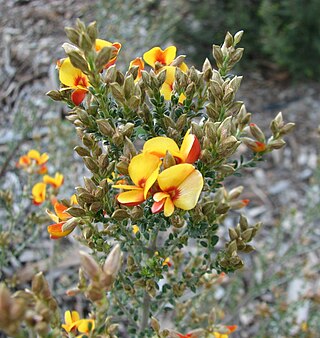
Mirbelia oxylobioides, commonly known as mountain mirbelia or sandstone bushpea, is a species of flowering plant in the family Fabaceae and is endemic to south-eastern Australia. It is a low-lying or erect shrub with narrowly elliptic to egg-shaped leaves and orange-yellow and reddish-purple flowers arranged near the end of the branches.

Micrantheum hexandrum, commonly known as box micrantheum, is a species of flowering plant in the family Picrodendraceae and is endemic to eastern Australia. It is an erect, monoecious shrub with oblong to narrowly lance-shaped leaves, and small white flowers with six or nine stamens. Picrodendraceae.
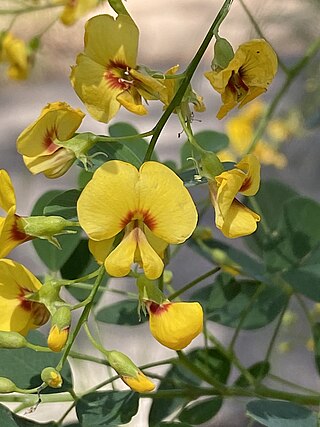
Goodia lotifolia, commonly known as golden tip or clover tree, is a species of flowering plant in the family Fabaceae and is endemic to eastern Australia. It is a sometimes tall shrub with trifoliate leaves, the leaflets narrowly egg-shaped with the narrower end towards the base, and bright yellow, pea-like flowers with red or brown markings.

Grevillea sessilis is a species of flowering plant in the family Proteaceae and is endemic to north-eastern Queensland. It is a shrub or small tree with divided leaves and cylindrical clusters of white flowers with a creamy-white or greenish yellow style.

Stachystemon polyandrus is a species of flowering plant in the family Picrodendraceae and is endemic to the southwest of Western Australia. It is a diffuse to straggling, monoecious shrub with crowded, oblong, elliptic or egg-shaped leaves with the narrower end towards the base, and small yellowish-white flowers arranged singly in upper leaf axils, but forming clusters at the ends of branches.

Olearia teretifolia is a species of flowering plant in the family Asteraceae and is endemic to south-eastern Australia. It is a bushy shrub with lance-shaped, egg-shaped or elliptic leaves arranged in opposite pairs, and white and yellow, daisy-like inflorescences.

Androcalva johnsonii is a species of flowering plant in the family Malvaceae and is endemic to central Queensland. It is a low, spreading shrub that has hairy young branches, narrowly egg-shaped or oblong leaves with rounded teeth, and small groups of white to pale pink flowers.

Billardiera viridiflora is a species of flowering plant in the family Pittosporaceae and is endemic to a small area in the north-west of Tasmania. It is a twining shrub that has narrowly elliptic leaves and pendent greenish yellow flowers that turn a deeper yellow as they age.
Ricinocarpos brevis is a species of flowering plant in the family Euphorbiaceae and is endemic to inland Western Australia. It is a monoecious, densely-branched shrub with narrowly oblong leaves and male and female flowers arranged singly or in small groups.
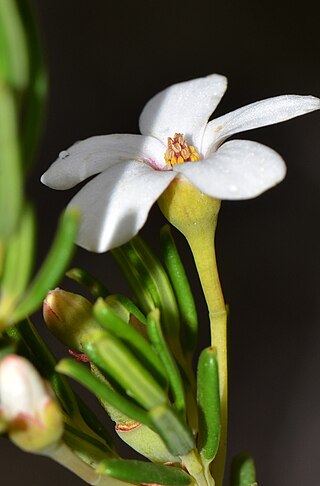
Ricinocarpos cyanescens is a species of flowering plant in the family Euphorbiaceae and is endemic to the south-west of Western Australia. It is a compact, monoecious shrub with narrowly oblong leaves and male and female flowers arranged singly or in small groups.
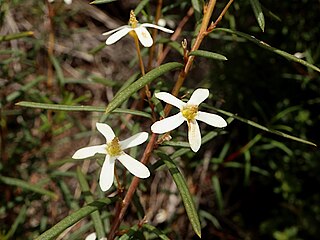
Ricinocarpos glaucus is a species of flowering plant in the family Euphorbiaceae and is endemic to the south-west of Western Australia. It is an erect, monoecious or dioecious shrub with linear or narrowly oblong leaves and male and female flowers arranged singly or in small groups.
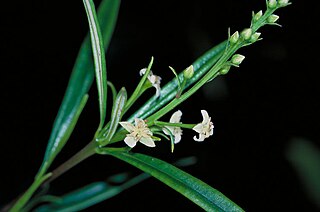
Ricinocarpos ledifolius is a species of flowering plant in the family Euphorbiaceae and is endemic to eastern Queensland. It is a monoecious or dioecious shrub or small tree with linear leaves and white flowers, arranged either singly, or with two or three female or two to six male flowers, or a single female flower surrounded by two male flowers.
Ricinocarpos marginatus is a species of flowering plant in the family Euphorbiaceae and is endemic to the north-west of Western Australia. It is an erect, monoecious shrub with narrowly elliptic leaves and white flowers arranged in groups of male flowers, or up to three female flowers surrounded by many male flowers.
Stachystemon intricatus is a species of flowering plant in the family Picrodendraceae and is endemic to the south-west of Western Australia. It is a compact, densely-branched, monoecious shrub with crowded, elliptic or egg-shaped leaves and small, cup-shaped white flowers arranged singly in upper leaf axils.
Stachystemon mucronatus is a species of flowering plant in the family Picrodendraceae and is endemic to the south-west of Western Australia. It is a compact, monoecious shrub with narrowly oblong or narrowly elliptic leaves and small, greenish yellow flowers arranged singly in upper leaf axils.
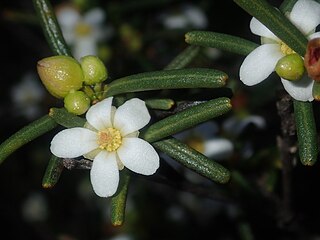
Ricinocarpos psilocladus is a species of flowering plant in the family Euphorbiaceae and is endemic to the west coast of Western Australia. It is an erect, open, monoecious or dioecious shrub with linear to narrowly oblong or narrowly egg-shaped leaves, and white or yellow flowers arranged singly, or with two to five male flowers, or a single female flower surrounded by up to three male flowers.
Stachystemon nematophorus is a species of flowering plant in the family Picrodendraceae and is endemic to the Kalbarri National Park in Western Australia. It is a woody, dense, compact, monoecious shrub with simple, oblong, elliptic or egg-shaped leaves with the narrower end towards the base, and small yellowish flowers arranged singly in upper leaf axils, but forming clusters at the ends of branches.
Stachystemon vermicularis is a species of flowering plant in the family Picrodendraceae and is endemic to the southwest of Western Australia. It is a diffuse, monoecious shrub with linear leaves and small red male flowers and yellowish female flowers arranged singly in upper leaf axils, but forming clusters at the ends of branches.
Stachystemon vinosus is a species of flowering plant in the family Picrodendraceae and is endemic to the southwest of Western Australia. It is a compact, monoecious shrub with narrowly egg-shaped or narrowly oblong leaves and maroon to purplish red and white male flowers and white female flowers arranged singly in upper leaf axils, but forming clusters at the ends of branches.
Stachystemon virgatus is a species of flowering plant in the family Picrodendraceae and is endemic to the southwest of Western Australia. It is a compact monoecious shrub with elliptic or narrowly oblong leaves and small yellow flowers arranged singly in upper leaf axils.












